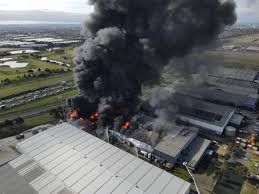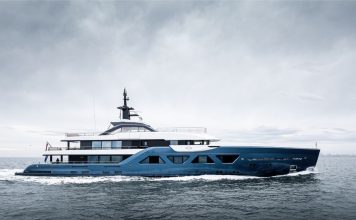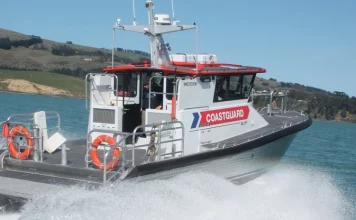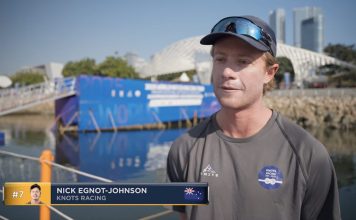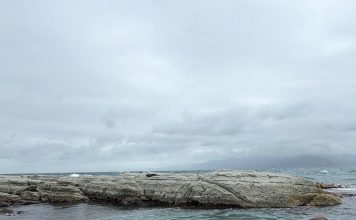In the last issue, Tom and Harriet had made it as far as Puerto Rico – two hops out of three on their way to Panama and the Pacific Ocean. This issue they reach Panama, where there are unexpected delays…
PUERTO RICO TO PANAMA – 905NM
Finally, we’d have an entire passage in the trade winds! We’d be seeing a lot of the trades, almost exclusively from the northeast at 17-21 knots, with gusts (read: squalls) to 26 knots. The course from Bouqueron, at the western end of Puerto Rico, to the entry breakwater at Panama is nearly dead downwind, so we’d be gybing to take advantage of shifts in wind direction and to avoid the near-permanent low-pressure system (possible winds to 35 knots, with steep, ugly current-againstthe-wind seas) that lurks off the northwest coast of Colombia. Our sail-carrying plan called for a single reef in the main, and OCEAN’s 95% overlap jib (on a jib-boom and roller-reefable) and furling Code 0 (non-reefable) to suit the daily variation in wind strength. Should be a breeze!
But just a couple of days out, we concluded that we’ve idealised the trade winds, just a wee bit. You know, running down the trades, sunshine and moonbows and postcard-perfect sunsets, that sort of thing.

“I can’t recall seeing so many squalls like this. Maybe on the passage from Fernando de Noronha, in Brazil,” said Harriet, gazing up at the towering cumulonimbus that had gathered around us. It was 10:45 on Day Three, and powerful squall clouds – to the south, the west, and the north – had triangulated on OCEAN. Each cloud announced itself with alarming gusts from an interesting direction, followed up by sheets of rain just short of a white-out. We had little choice but to reef down or furl up as the clouds came over, blocking out the sun. We’d peer out at the rain, ready to let the mainsail halyard fly or roll up the headsail. Then we’d turn the ignition key and trundle along behind the squall in weak, ascending air and leftover chop. The squalls meant more sail-handling work and slower progress – and nighttime squalls seemed worse in every way. We don’t mind a few trade wind squalls now and then, but this?
One evening, a prolonged 25-plus-knot blast sent us surfing down a steep sea at 18 knots. The autopilot steered blithely onward (OCEAN’s hulls have lots of buoyancy forward, and a cat’s twin hulls are not as prone to broaching as a monohull’s). But the brief thrill ride through the darkness freaked us out. We double-reefed the main – we are happy averaging 8 to 9 knots, we don’t need 18 – and concluded that we needed a better sail strategy for running deep in intensified trades.

Later, we talked to a cat crew on the same passage who had used a reefed jib only – the mainsail stayed in the lazy bag. In the Pacific we’d be experimenting with winging out the jib only, running in big breeze – our jib-boom made the sail efficient, and the jib is far easier than the mainsail to reef and furl. We need to keep reminding ourselves that, even though we are ex-racers, we are not in a race. We love fast passages, but quality off-watch rest for our two-handed crew is the top priority.
When we pulled in the second reef, we disturbed a redfooted booby that had taken up residence on our solar panels – the bird squawked, moved to the tip of the port bow, tucked its beak into its wing, and continued sleeping. Later, we found a small black bird, maybe a petrel, snoozing on the dinghy davits, the bird’s little legs flexing with the seas that were bouncing OCEAN. Later still, a flying fish flew into our dinghy. All of it seemed to say: you are in the trade winds, and you are a part of the trade winds, so pull your socks up. Enjoy!
Some evenings, of course, were astoundingly beautiful with an impossible canopy of stars arcing across the horizon. “There’s the Southern Cross!” said Harriet, our resident star watcher. The Southern Cross, which has a saucy tilt when viewed from 16°N latitude, is her favourite – New Zealand is kind of just over the horizon. We’d brought along the sextant we’d used on our 28-foot Freelance in 1988, and we planned to revive our celestial skills in the Pacific. Plus, taking star sights with a sextant puts a perspective on your humble place in the universe that a GPS fix never will.

Nearing Panama, the trade winds mellowed out; 15 knots, 20 in squalls (and far fewer of them), and the seas grew smaller and kinder. These are more like the trades we remember. Mellow Pacific trades. By the time we’d gybed into the inbound lane of the ship traffic separation scheme for the Panama Canal, I’d finished David McCullough’s 700-page history of the Canal, The Path Between the Seas, so I was already in awe of the place. The 40-year creation of the Canal, the largest engineering and construction project attempted before or since, is an astounding story.
An estimated 25,000 workers died from malaria, yellow fever, cholera, typhoid, pneumonia, dengue, and dysentery. Workers died in industrial accidents involving giant steampowered shovels and excavators, and dynamite and landslides. West Indian labourers cleared swathes of tropical jungle with machetes. People went mad in the four metres of annual rainfall, the mud that stuck fast to boots and shovels, the stifling heat and humidity, the swarms of bugs. A raging river and a mountain range of sliding mud and boiling pits were tamed at great cost. An unlikely cast of characters – a charismatic French entrepreneur, three US Presidents (Roosevelt, Taft, and Wilson), battalions of engineers, hundreds of military brass and thousands of service members – persevered and triumphed against all odds. And to think that we’d take our sailboat through this wonder with no more than canal fees and sunburn…
Surprise! We are stuck for three weeks: issues with mainsail batten pocket ends and steering cylinders (OCEAN has hydraulic steering) have us tied up in Shelter Bay Marina, at the entrance to the canal. Fortunately, Sheyla, the marina’s shipment wizard, wrangles our repair materials through DHL’s Christmastime crush. And the help we need – Troy the sailmaker, and Bill, Carlos, and Jonathan the hydraulic guys – is on hand. Karen and Paul Prioleau, cruisers we’d met in Baja and the South Pacific back in 1988, fly in and join us as line-handlers for the Canal transit. Away we go!

Roy, our Panama Canal Authority pilot/advisor, and Juan, our specified line-handler, have over 2,000 Canal transits between them. So, other than some well-timed line handling to counter the propwash from the container ship in front of us and upwelling during the flooding of the locks, the 10-hour transit is easy. The Canal’s clever gravity-fed layout of dammed lakes and rivers, water chambers, and valves, and the silent precision of its machinery, much of it the original steel castings from Pennsylvania and West Virginia, along with its present-day million-dollar tugs and the million-dollar, one-way ticket for a Panamax ship, is a marvel.
These 47 miles are both a milestone and the gateway to a new life for Harriet and me and OCEAN. By the time 26 million gallons (98,420,706.4 litres) are drained from the Miraflores Lock, lowering us 27 feet (8.3m) to sea level, and we motor around the bend and under the final bridge, we see a thin blue horizon waiting ahead: the Pacific. BNZ















